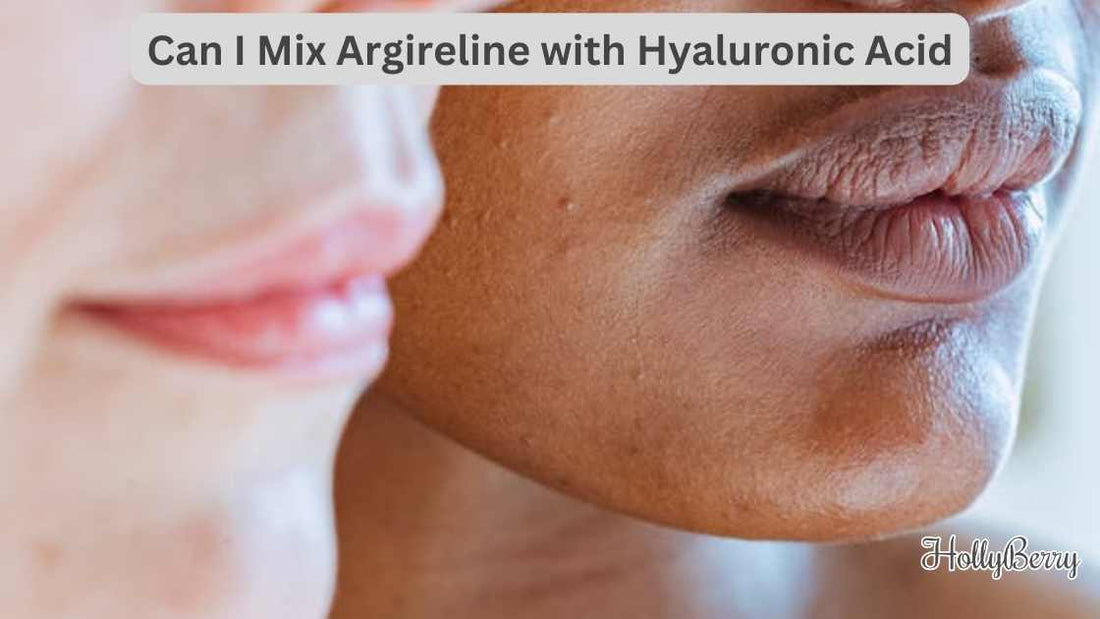
Can I Mix Argireline with Hyaluronic Acid
Share
Compatibility and Benefits Explained

When exploring the burgeoning realm of skincare, one often stumbles across various ingredients that claim to turn back the hands of time and deliver a youthful glow.
Among these, Argireline emerges as a prominent peptide known for its potential to reduce the appearance of fine lines and wrinkles by intercepting neurotransmitter signals that cause muscles to contract.
On the other hand, hyaluronic acid is revered for its intense hydration properties, capable of holding up to 1000 times its weight in water, thus providing the skin with lasting moisturisation.
The combination of Argireline and our hyaluronic acid in skincare routines has been a topic of interest for individuals seeking to get the most out of their serums.
It is often recommended to layer skincare products from thinnest to thickest consistency, which typically positions serums before creams and oils.
As both Argireline and hyaluronic acid are found in serum formulations, they can be used concurrently, capitalising on Argireline's muscle-relaxing prowess and hyaluronic acid's profound ability to bind water to the skin, potentially creating a synergistic effect.
Consumers are encouraged to apply products containing Argireline and hyaluronic acid to clean, slightly damp skin.
This practice is not only deemed safe but potentially beneficial, as it can improve the penetration of the active ingredients and heighten their efficacy.
It is suggested to follow these serums with a moisturiser to seal in the hydration and to provide an occlusive barrier, thereby maximising the benefits of their combined use.
Understanding Argireline and Hyaluronic Acid
This section offers insights into the compatibility and benefits of incorporating Argireline and hyaluronic acid into your skincare routine, focusing on their roles in anti-ageing and hydration.
The Role of Peptides in Anti-Ageing
Argireline, scientifically known as Acetyl Hexapeptide-8, is a peptide renowned for its anti-ageing properties.
Peptides are short chains of amino acids that signal the skin to produce more collagen and elastin, pivotal for reducing the appearance of fine lines and wrinkles.
Specifically, Argireline inhibits the mechanisms that cause expression lines, often marketed as a topical alternative to cosmetic procedures.
Hyaluronic Acid for Hydration
Hyaluronic acid is a molecule revered for its ability to retain moisture, it can hold up to 1,000 times its weight in water. This hydration powerhouse is essential for maintaining skin elasticity and cushioning, combating dry skin and dehydration, two common skincare concerns.
Combining Argireline with Hyaluronic Acid
Layering Argireline with hyaluronic acid can be synergistic; while Argireline targets expression lines, hyaluronic acid provides the hydration necessary to support smooth skin.
It is generally safe for sensitive skin, as hyaluronic acid naturally occurs in the body and Argireline does not typically cause side effects.
Furthermore, this combination is found in various forms, such as serums and creams, making it versatile for different skincare routines.
Application and Efficacy
In the quest for youthful skin, combining Argireline and hyaluronic acid can be an effective strategy. This section focuses on their proper application and the potential for skin reactions.
Correct Application of Argireline and Hyaluronic Acid
For optimal results, Argireline Solution 10% should be applied to clean skin before the use of creams or oils. It may be paired effectively with hyaluronic acid, which functions as a hydrating ingredient.
As Argireline mimics the effects of Botox by limiting muscle movement and thereby reducing wrinkles, using it in conjunction with a moisture-binding agent like hyaluronic acid can enhance skin texture and hydration levels.
- Cleanse the skin thoroughly.
- Apply Argireline Solution 10% to areas prone to dynamic folds such as the forehead and around the eyes.
- Follow up with a hyaluronic acid serum to deeply hydrate the skin.
- Finalise with a moisturiser to lock in the actives.
It is prudent to avoid combining Argireline with direct acids or pure Vitamin C, as these may affect the integrity of the peptide. Patch-testing prior to full application is recommended to ascertain skin tolerance.
Potential Side Effects and Skin Reactions
While Argireline is generally well-tolerated, individuals with sensitive skin types or conditions like rosacea may experience reactions.
One should conduct a patch test to minimise risks of allergic reactions. Side effects may include mild irritation or redness at the application site.
Hyaluronic acid is generally safe for all skin types, including oily skin; however, its misuse can lead to an over-hydrated state and potential breakouts. Users are advised to monitor their skin's response, especially when introducing new products into their routine.
If any negative reactions occur, discontinue use immediately and consult a skincare professional.
